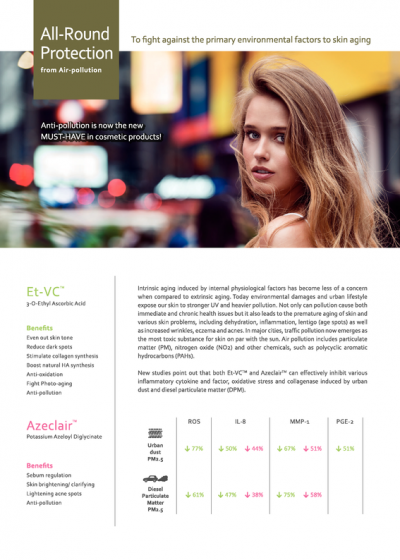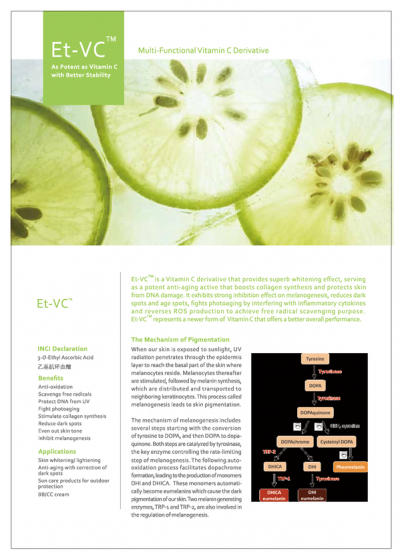Promotional Features
Epi-On - Skin recovery and strengthening through epigenetic pathway
A skin lesion is one of the permanent types of skin damage that usually has negative social impacts for both men and women and it also associates with skin irritation, discomfort and redness. Clinical procedures such as laser treatment, skin needling or dermabrasion can weaken and destroy the outermost layer of the epidermis and leave a mild inflamed on the surface of skin. The weakened and damaged skin barrier generally will undergo an innate rejuvenating and healing mechanism of the skin which takes a period of time to restore and recover. Therefore, an active ingredient that imparts soothing, repairing weakened and damaged skin with shortened recovery time is appealing to the cosmetic market.
Mechanism of skin repair and scarring
A physiological process of cutaneous wound healing is complicated and dynamic. It requires wound-edge cells to proliferate, migrate and differentiate through collaborative efforts of both molecular and cellular mechanisms. The cutaneous wound healing proceeds with three major overlapping phases: (A) inflammation phase, where white blood cells create swelling, redness and heat at the wound sites to trigger inflammatory responses; (B) cell proliferation phase, where fibroblasts proliferate and contribute to tissue boundary formation; (C) matrix remodeling, where ECM deposition and new blood vessels formation can be observed at the wound site.
In general, acne lesions require a week or two to heal, while the recovery speed of post-procedure skin depends on the frequency the skin undergoes clinical treatments. Nonetheless, unpleasant post-acne marks as well as, red, sensitive post-procedure skin often leave uneven skin tone, hyperpigmentation and are prone to infection. Consequently, an effective healing process plays an essential and crucial role in repairing and reconstructing skin to prevent excessive scar formation as well as improve healing response.
Epi-On plays a role in the epigenetic pathway
Corum developed a new-patented active Epi-On which aims to protect skin and accelerate tissue repair mechanisms through epigenetic regulation. An “On and Off” epigenetic switch is a common mechanism that influences the transcription and translation of genes to proteins without altering the DNA sequence. The most characteristic epigenetic modifications are histone modifications which are controlled by two enzymes, histone acetyltransferases (HAT) and histone deacetylases (HDAC).
HDAC is a class of enzymes that remove acetyl groups from DNA-wrapped histones, thus altering the chromatin structure and accessibility furthermore to downregulate cellular functions(1). HDAC activity tends to increase with biological aging as well as tissue damage. Meanwhile, HATs act as the writer which promote protein expression and prevent damage by adding acetyl groups to the histone proteins. Epi-On is able to attenuate HDAC activity in a dose-dependent manner and upregulate histone acetylation to increase gene expression of various growth factors EGF, TGF-β1, TGF-β2, IGF1 and VEGFA involved in the proliferation and differentiation of keratinocytes and fibroblasts.
Epi-On also imparts anti-inflammatory and anti bacterial effects that reinforce the wound closure process and enhance tissue repair. This proprietary compound is highly water soluble and easy to formulate into cosmetic products such as post-acne treatments as well as post-procedure treatments for the sensitive and damaged skin.
Epi-On stimulates skin repairing process and strengthens skin barrier
To evaluate Epi-On’s efficacy on the skin barrier and damaged tissue, a study was conducted by a French testing institute BIO-EC, aiming to assess Epi-On’s ability to repair and strengthen weakened skin. After staining according to Masson’s trichrome, the skin morphology and bud length growth were analyzed on day 3 and day 10. The results demonstrate that Epi-On significantly improved the thickness of stratum corneum and accelerated recovery speed. 2% and 4% of Epi-On increased the bud length growth by 17% and 40% respectively on day 3.
The application of Epi-On on human skin was proven to help restore homeostasis and regeneration of weakened skin.
Fibronectin resides in the basal lamina of the extracellular matrix and interacts with specific integrins to direct cell behavior as well as tissue behavior. Integrins serve as cell adhesion receptors that present in the dermal-epidermal junction (DEJ) and associate with actin filaments (2). Assembly of both proteins is crucial for keratinocytes’ migration, proliferation and differentiation to restore skin barrier function. To visualize fibronectin and integrin β4 on the edge of lesion of wounded human explants, the immunostaining assay was performed. 4% Epi-On significantly increases 59% of fibronectin and 14% of integrin β4 expression at the edge of the lesion on day 3 and day 10, respectively.
Conclusion
Epi-On is a novel patented active which promotes skin repair through epigenetic histone modification pathway and accelerates cutaneous healing mechanism in both epidermis and dermis layers of human skin.
Various conducted studies have shown the benefits of Epi-On to skin:
- Promote the strengthening of the weakened skin barrier
- Stimulate the repairing of damaged tissue
- Accelerate tissue regeneration
- Lighten the appearance of marks, spots and scars on skin
- Protect skin against oxidative stress
- Attenuate 5α-reductase activity
- Anti-inflammation
- Anti-bacteria
All these benefits are interdependent. Its water-soluble property further enlarges the applicability in cosmetics formulations especially for post-acne, post-procedure and post-shaving products.
For more information, please visit www.corum.com.tw
Reference:
1. Gibney, E. R. & Nolan, C. M. (2010). Epigenetics and gene expression. Heredity, 105(1), 4–13.
2. Leeni K. et al (2014). Integrins in Wound Healing. Adv Wound Care, 3(12), 762–783.








